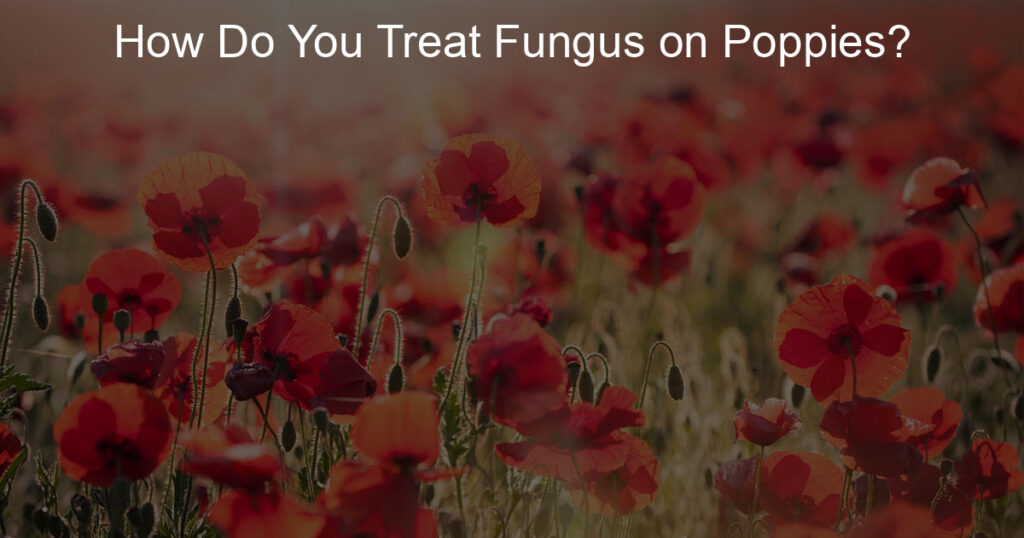Poppies are fast-growing annuals that thrive in wet, cool climates. They are also susceptible to fungal diseases. Poppy plants often display chlorosis, premature flower drop and poor branching. Fungal pathogens, such as Phytophthora root rot, Pythium damping-off and Fusarium wilt can cause these issues in poppies. Poppies are susceptible to fungal diseases such as powdery mildew, verticillium wilt, sclerotinia and Ustilago tritici blotch.
Symptoms of fungal infection on poppies include stunted growth with yellow leaves; sunken lesions; rapid wilting of the plant; yellowish discolored spots on foliage; deformed flowers or no flowers at all. Fungal diseases attack the roots first before they spread and destroy the entire plant. Verticillia wilt is caused by Verticillium dahliae while Pythium damping-off attacks plants through rhizomes (roots) or roots. Sclerotinia stem rot attacks plants by attacking their vascular system (in other words, it grows in the stems). If you notice any of these signs on your poppy plants, consult a greenhouse professional to get a diagnosis for proper treatment and preventative measures.
What time of day should I spray for powdery mildew?
Powdery mildew is a fungus that attacks the leaves of poppies. It usually starts on the lower leaves and slowly spreads to cover the entire plant. The best time to spray for powdery mildew is in early morning or in late afternoon. Spraying too late will result in less than effective control of powdery mildew.
What is the best cure for powdery mildew?
Powdery mildew is a fungal disease that occurs when the spores of Microsporea fungus infect the plant. The symptoms are powdery white fungal growth on leaves, stems and flowers.
If you notice powdery mildew on your poppies, you might want to consider using an organic fungicide spray. Organic fungicides include copper sulfate, bordeaux mixture, sulfur and mancozeb (maneb). Copper sulfate is a toxic chemical that will kill the powdery mildew but won’t harm the plant. It’s recommended to mix it with a non-toxic fungicide like bordeaux mixture or sulfur. Mancozeb is a chemical compound that kills fungi by inhibiting chitin synthesis in their cells.
What do you do for a poppy blight?
If you have a poppy blight, the best way to treat it is to remove infected plants from the garden and clean and sterilize the soil before replanting.
Poppy plants are propagated by seed or by layers of several shoots. If you are growing your poppies from seed, you should plant them in sterile soil for optimal success. When you propagate your poppy plants, use sterile tools and materials when handling your plants. This can help prevent spreading disease and help maintain a healthy ecosystem. When propagating your poppy plants, take care not to overwater them so that they do not become stunted or discolored.
As soon as you notice any signs of fungus on your flowers or leaves, stop watering and remove affected material from the soil or pots immediately.
When grown in pots, cease fertilizing as soon as symptoms of fungal infection manifest themselves. Fungal diseases thrive on nutrient-rich soils so avoid fertilizing for two weeks after symptoms show up. If you want to continue with fertilizer during this time period, make sure it’s only organic composted manure that has been screened out at least 12 inches deep as this will decrease chances of spread from contaminated seeds used in propagation.
Will powdery mildew go away?
Powdery mildew is a common fungal disease that afflicts poppies. This disease manifests as white (or gray) powdery or velvety spots on the surface of leaves and petals. Powdery mildew causes leaves to turn yellow and drop off, which can sometimes affect flowers too. The fungus spreads easily through air movement, but it can also be spread from plant to plant via infected soil, water or other plants.
If your poppy plants are showing symptoms of powdery mildew, chances are that you have not been watering them enough. It is important to remember that this disease thrives in wet conditions so if the weather is dry, you should make sure you are watering your plants appropriately. If your garden is located in a damp area and you see these signs on your plant, avoid overhead irrigation as overhead irrigation dries out the topsoil where the fungus thrives while overhead irrigation doesn’t reach the roots of your plant. Also consider using mulch around your plants to help keep moisture in the ground and prevent powdery mildew from spreading.














